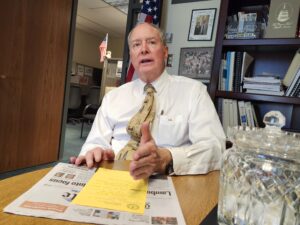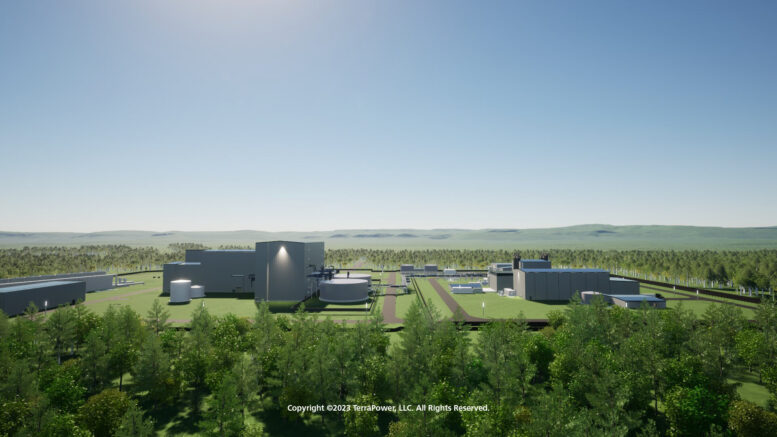Nuclear energy is on the lips of many people these days — federal officials pushing it as a source of clean energy, leaders of other states beginning to study and utilize it and investors seeking to take advantage of incentives to boost this sector.
In Colorado, however, there hasn’t been an active generator of nuclear power since the Fort St. Vrain Nuclear Generating Station closed in 1989, and the state’s intensive efforts to boost clean energy sources have focused almost exclusively so far on wind- and solar-power generation. Sen. Larry Liston wants to change that, particularly in the wake of a report recommending conversion of a Pueblo coal-powered plant into one that’s nuclear-powered, and the Colorado Springs Republican will make his case to a legislative committee Wednesday.
Liston’s Senate Bill 39, scheduled for an afternoon hearing that day before the Senate Transportation and Energy Committee, would redefine nuclear energy in state law as a clean energy, just like wind, solar, geothermal, green hydrogen and small hydroelectricity. The effect of such a reclassification would be to allow nuclear energy to count toward the state’s goal of having a 100% clean-energy grid by 2050 and qualify nuclear projects for the Rural Clean Energy Project Finance Program.
Why Liston supports nuclear energy
In an interview, Liston acknowledged that the immediate effect of such a law might be minimal, as there are no potential nuclear-energy projects that hinge on the passage of SB 39. But he believes that if Colorado joins the chorus of states sending signals that they are open to investment in nuclear, it will gain an edge in competing for projects in the future.
“I’m doing this because I firmly believe it’s the right thing to do for the greater good of Coloradans and the energy environment,” said Liston, emphasizing he’s not bringing the bill at the behest of any company or interest group. “As good as wind and solar may be, they’re not going to fill the big hole of coal and natural gas in our grid. They’re not as reliable.”

Colorado state Sen. Larry Liston speaks about his nuclear-energy bill in his Capitol office.
But he will have a significant number of obstacles to overcome to pass the bill.
SB 39 is going to the same committee that killed a very similar bill on a party-line vote one year ago. Nuclear power continues to generate significant opposition from environmental groups like the Sierra Club that hold great sway with the Legislature. And, in a twist, the same committee of Puebloans that recommended replacing Xcel Energy’s Comanche 3 coal-fired plant with a nuclear-energy generator is fighting his bill.
Is nuclear energy clean?
Liston’s first argument is one that’s also being made by the administration of President Joe Biden — someone with whom the veteran Republican rarely agrees. Because nuclear does not produce carbon dioxide, he argues, it offsets emissions and is needed to supplement wind and solar, as it’s able to generate electricity at full design capacity at rates two to five times higher than those weather-dependent sources.
Several committee members last year disagreed with his assessment of its cleanliness, with Sen. Lisa Cutter, D-Morrison, saying that there remain too many unknowns around areas like what to do with used fuel to change statute and declare nuclear energy as clean. The Sierra Club runs a Nuclear Free Campaign Grassroots Network, arguing the world has seen three serious disasters at nuclear plants in just the past 60 years, making it an unsafe alternative.
“Besides reactor safety, both nuclear proliferation and the required long-term storage of nuclear waste (which remains lethal for more than 100,000 years) make nuclear power a uniquely dangerous energy technology for humanity,” the organization says on its Nuclear Free Future website.
Yet, states across the political spectrum, from Wyoming to Illinois, are embracing nuclear energy in new ways.
A federal and national push

Christine Csizmadia is a senior director with the Nuclear Energy Institute.
Three states redefined nuclear as clean energy in 2023, and Minnesota and Michigan passed new clean-energy standards that include nuclear as a clean source, noted Christine Csizmadia, senior director for state government affairs and advocacy for the Nuclear Energy Institute. Five states recently implemented efforts to study nuclear energy or the potential for small modular reactors, and six states since 2016 have repealed moratoria on nuclear-energy sources.
“Over the last several years, there has been a really significant increase in momentum for nuclear policy in states that are both blue and red,” Csizmadia said. “And (SB 39) is pretty on-measure with what is happening in other states.”
The bill also comes as the federal government is floating new incentives for nuclear-energy development after categorizing it as clean energy in laws that offer production tax credits for existing energy plants and investment tax credits for new facilities. Energy Secretary Jennifer Granholm in 2022 said that the Department of Energy “is taking critical steps to strengthen nuclear development — helping ensure the United States is on track to a clean energy future.”
Earlier this month, the topic of nuclear hit home in a new way for Colorado when a local committee examining how to replace the economic impact of a shuttering coal plant in Pueblo declared that only a nuclear power plant could replace the facility with enough jobs and tax impact to make the community whole. The committee recommended that Xcel Energy consider building small nuclear modules and a new combined cycle gas plant with carbon capture to avoid a massive loss of economic activity and produced power there.
Nuclear reactor in Pueblo?
But while Frances Koncilja, co-chair of the committee, told The Sum & Substance that the state needs to do more to attract developers of nuclear energy and to discuss it as a viable source of power, she also said that SB 39 is not the way to do it.
In redefining nuclear as clean energy, the bill would change the way that assessors determine the property tax valuation of nuclear facilities and energy equipment, Koncilja said. A 2021 bill declared that clean-energy equipment is to be taxed not on a depreciating basis from its original cost but based on income generated and factored over 30 years, which reduces tax revenues, particularly in the near term, she argued.
A presentation to the Pueblo committee stated that while that 2021 law has cut property-tax revenue from a range of clean-energy equipment, it still would allow for significant tax revenue coming from small modular reactors. And for communities like Pueblo or northwest Colorado that are transitioning away from the coal power that has provided an economic base to the community, that revenue is vital, Koncilja said.
“It does bother me because of the unintended consequences,” Koncilja said of SB 39. “In my opinion, Senate Bill 21-020 was a financial disaster for local communities.”
“Isn’t going to go away”
Liston disagreed with Koncilja’s interpretation of the interplay of that law and his bill and said he does not believe it will cause financial problems for local communities. But he remains at odds with Pueblo officials on that.
As Gov. Jared Polis has pushed for production of more forms of clean energy in Colorado but also has said that many of them are more cost-efficient than nuclear, the future of the energy source — and the state’s ability to attract investment in it — remains in limbo. Even as a U.S. Department of Energy report called nuclear “one of the few proven options” to boost clean energy at the scale the country needs, Colorado is looking elsewhere.
Wednesday’s hearing will demonstrate whether there’s any interest in adding to the state’s portfolio of clean fuels or whether legislators believe Colorado can achieve its emissions-reduction goals with wind, solar, geothermal and hydrogen.
“This isn’t going to go away,” Liston said of the debate. “There needs to be a place for nuclear energy in our energy portfolio.”
